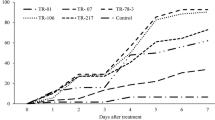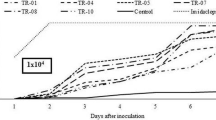Abstract
The susceptibility of Megalurothrips sjostedtito Metarhizium anisopliae when reared on susceptible, tolerant, and moderately resistant varieties of cowpea at different constant temperatures was evaluated in the laboratory. Insects were exposed either to direct spray of the conidia or to fungus-treated floral tissues. Mortality was significantly higher on the moderately resistant variety at all temperatures compared to the susceptible and tolerant varieties. Correspondingly, lethal time and lethal concentration values were significantly shorter and lower, respectively, on the moderately resistant variety compared to the other varieties, thus indicating that the two control methods are compatible as part of an integrated pest management strategy. Thrips raised on the tolerant variety incurred an exceptionally low level of mortality when the inoculum was sprayed directly on the insects or when the insects were exposed tofungus-treated floral tissues. Observations on the effects of airborne volatiles and crude extracts of this variety revealed an inhibitory effect on fungal germination, colony forming units and growth. This suggests the existence of anti-fungal substances in the tolerant variety.
Similar content being viewed by others
References
Abbott, W.S., 1925. A method of computing the effectiveness of an insecticide. J.Econ. Entomol. 18: 265–267.
Allen, D.J., 1983. The Pathology of Tropical Food Legumes: Disease Resistance in Crop Improvement. John Wiley & Sons, New York.
Benz, G., 1987. Environment. In: J.R. Fuxa and Y. Tanada (eds), Epizootiology of Fungal Diseases. John Wiley & Sons, New York. pp. 177–214.
Bong, C.F.J., P.P. Sikorowski and F.M. Davis, 1991. Effect of a resistant maize genotype and cytoplasmic polyhedrosis virus on growth and development of the Corn Earworm (Lepidoptera: Noctuidae). Environ.Entomol. 20: 1200–1206.
Burgerjon, A., 1956. Pulvérisation et poudrage au laboratoire par des préparations pathogènes insecticides. Ann.Epiphytol. 4: 677–688.
Butt, T.M. and M. Brownbridge, 1997. Fungal pathogens of thrips. In: T. Lewis (ed), Thrips as Crop Pests. CAB International, Wallingford. pp. 399–433.
Carnovale, E., L. Marietta, E. Marconi and E. Brosio, 1990. Nutritional and hydration properties in cowpea. In: N.Q. Ng and L.M. Monti (eds), Cowpea Genetic Resources. Amarin Printing, Thailand. pp. 111–118.
Carruthers, R.I. and R.S. Soper, 1987. Fungal diseases. In: J.R. Fuxa and Y. Tanada (eds), Epizootiology of Fungal Diseases. John Wiley, New York. pp. 357–416.
Duffey, S.S. and K.A. Bloem, 1986. Plant defense-herbivore-parasite interactions and biological control. In:M. Kogan (ed), Ecological Theory and Pest Management Practice. Wiley, New York. pp. 135–183.
Ekesi, S., N.K. Maniania, I. Onu and B. Lohr, 1998a. Pathogenicity of entomopathogenic fungi (Hyphomycetes) to the legume flower thrips, Megalurothrips sjostedti (Trybom) (Thysanoptera: Thripidac). J.Appl.Entomol. 122: 629–668.
Ekesi, S., N.K. Maniania and I. Onu, 1998b. Antibiosis and antixenosis of two cowpea varieties to the legume flower thrips. Afric.Crop Sci.J. 6: 49–59.
Ekesi, S., N.K. Maniania and K. Ampong-Nyarko, 1999. Effect of temperature on germination, radial growth and virulence of Metarhizium anisopliae and Beauveria bassiana on Megalurothrips sjostedti. Biocontrol Sci.Technol. 9: 177–185.
Felton, G.W., S.S. Duffey, P.V. Vail, H.K. Kaya and J. Manning, 1987. Interaction of nuclear polyhedrosis virus with catechols: potential incompatibility for host-plant resistance against noctuid larvae. J.Chem.Ecol. 13: 947–957.
Ferron, P., 1978. Biological control of insect pests by entomogenous fungi. Annu.Rev. Entomol. 23: 409–442.
Hare, D. 1992. Effect of plant variation on herbivore-natural enemy interactions. In: S.R. Fritz and E.L. Sims (eds), Plant Resistance and Diseases: Ecology, Evolution and Genetics. University of Chicago Press, Chicago. pp. 278–298.
Hare, D.J. and T.G. Andreadis, 1983. Variation in the susceptibility of Leptinotarsa decemlineata (Coleoptera: Chrysomelidae) when reared on different host plants to the fungal pathogen, Beauveria bassiana in the field and laboratory. Environ.Entomol. 12: 1892–1897.
Jackai, L.E.N. and C.B. Adalla, 1997. Pest management practices in cowpea: a review. In: B.B. Singh, D.R. Mohan-Raj, K.E. Dashiell and L.E.N. Jackai (eds), Advances in Cowpea Research. Sayce Publishing, Devon. pp. 240–258.
Jackai, L.E.N. and R.A. Daoust, 1986. Insect pests of cowpeas. Annu.Rev.Entomol. 31: 95–119.
Lattanzio, V., V. Linsalata, G. Maruca, R. Marullo, B.B. Singh, S.R. Singh and P. Perrino, 1990. Pre-existing phenols and resistance to aphid in cowpea (Vigna unguiculata (L.) Walp). In: N.Q. Ng and L.M. Monti (eds), Cowpea Genetic Resources. Amarin Printing, Thailand. pp. 128–134.
Lattanzio, V., V. Linsalata, A. Cardinalli, D. Di Venere, C. Cariddi, R.Marullo, G.Maruca and P. Perrino, 1992. Endogeneous flavonoids and resistance to aphids in Vigna unguiculata lines. Groupe Polyphenols 16: 275–278.
Lwande, W., P.G. McDowell, H. Amiani and P. Amoke, 1989. Analysis of airborne volatiles of cowpea. Phytochemistry 28: 421–423.
Maniania N.K., 1994. A laboratory technique for infecting adult tsetse with fungal pathogen. Insect Sci.Appl. 15: 421–426.
Maniania, N.K., K.N. Saxena and A. Odulaja, 1998. Influence of sorghum host plant cultivars on the activity of the entomopathogenic fungus Metarhizium anisopliae (Metsch.) Sorok. against Chilo partellus (Swinhoe). Insect Sci.Appl. 18: 45–52.
Meade, T. and D. Hare, 1994. Effect of genetic and environmental host plant variation on the susceptibility of two noctuids to Bacillus thuringiensis. Entomol.Exp.Appl. 70: 165–178.
Pare, P.W., J. Zajicek, V.L. Ferracini and I.S. Melo, 1993. Antifungal terpenoids from Chenopodium ambrosiodes. Biochem.System.Ecol. 21: 61–67.
Parella, P.M. and T. Lewis, 1997. Integrated pest management (IPM) in field crops. In: T. Lewis (ed), Thrips as Crop Pests. CAB International, Wallingford. pp. 599–614.
Pathak, R. S and J.C. Olela, 1986. Registration of 14 cowpea cultivars. Crop Sci. 26: 647–648.
Ramoska, W.A. and T. Todd, 1985. Variation in efficacy and viability of Beauveria bassiana in the Chinch bug (Hemiptera: Lygaeidae) as a result of feeding activity on selected host plants. Environ.Entomol. 14: 146–148.
Richardson, D.P., A.C. Messer, S. Greenberg, H.H. Hagedorn and J. Meinwald, 1989. Defensive sesquiterpenoids from a dipterocarp (Dipterocarpus kerri). J.Chem.Ecol. 15: 731–747.
Roy, A.N. and R.B. Sharma, 1982. Effect of Vigna mango L. seed-coat-leachate oil on fungal growth. Phytopathol.Medit. 21: 31–32.
SAS Institute, 1990. SAS/STAT User's Guide. Version 6, Fourth Edition, Volume 2. SAS Institute, Cary, N.C.
Singh S.R. and D.J. Allen, 1980. Pest, diseases, resistance and protection in cowpeas. In: R.J. Summerfield and A.H. Bunting (eds), Advances in Legume Sciences. Royal Botanic Gardens and Fisheries, Kew, MAFF, London. pp. 419–443.
Smith, C.M., 1989. Plant Resistance to Insects: A Fundamental Approach. John Wiley and Sons, New York.
Smith, D.A., 1982. Toxicity of Phytoalexins. In: J.A. Bailey and J.W. Mansfield (eds), Phytoalexins. Blackie and Sons, Glasgow and London. pp. 218–252.
Smith, D.A. and J.L. Ingham, 1980. Legumes, fungal pathogens, and phytoalexins. In: R.J. Sumrnerfield and A.H. Bunting (eds), Advances in Legume Science. Royal Botanic Gardens, Kew, MAFF, London. pp. 207–223.
Van Emden, H.F. 1987. Cultural control: the plant. In: A.J. Burn, T.H. Coaker and P.C. Jepson (eds), Integrated Pest Management. Academic Press, New York. pp. 27–68.
Vega, F.E., P.F. Dowd, M.R. McGuire, M.A. Jackson and T.C. Nelsen, 1997. In vitro effects of secondary plant compounds on germination of blastospores of the entomopathogenic fungus Paecilomyces fumosroseus (Deuteromycetes: Hyphomycetes). J.Invert.Pathol. 70: 209–213.
Author information
Authors and Affiliations
Rights and permissions
About this article
Cite this article
Ekesi, S., Maniania, N. & Lwande, W. Susceptibility of the legume flower thrips to Metarhizium anisopliae on different varieties of cowpea. BioControl 45, 79–95 (2000). https://doi.org/10.1023/A:1009927302916
Issue Date:
DOI: https://doi.org/10.1023/A:1009927302916




